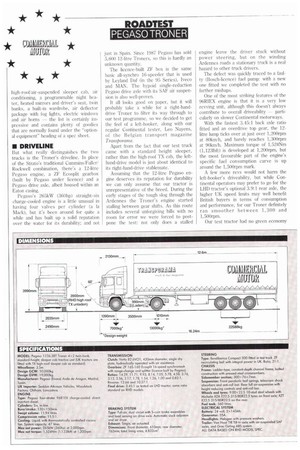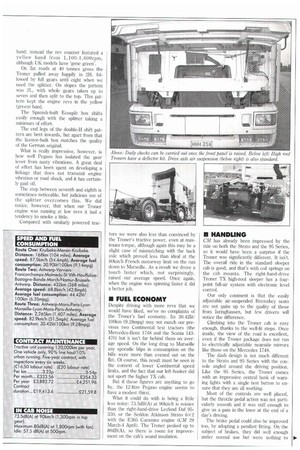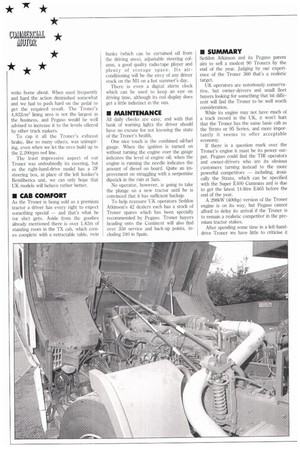ROADTEST PEGASO TRON ER
Page 52

Page 53

Page 54

Page 55

If you've noticed an error in this article please click here to report it so we can fix it.
high-roof/air-suspended sleeper cab, air conditioning, a programmable night heater, heated mirrors and driver's seat, twin bunks, a built-in wardrobe, air deflector package with fog lights, electric windows and air horns — the list is certainly impressive and contains plenty of goodies that are normally found under the "optional equipment" heading of a spec sheet.
But what really distinguishes the two trucks is the Troner's driveline. In place of the Strato's traditional Cummins/Fuller/ Rockwell combination, there's a 12-litre Pegaso engine, a ZF Ecosplit gearbox (built by Pegaso under licence) and a Pegaso drive axle, albeit housed within an Eaton casing.
l'egaso's 265kW (360hp) straight-six charge-cooled engine is a little unusual in having four valves per cylinder (a la Mack), but it's been around for quite a while and has built up a solid reputation over the water for its durability; and not just in Spain. Since 1987 Pegaso has sold 5,6(X) 12-litre Ironer% so this is hardly an unknown quantity.
The licence-built ZF box is the same basic all-synchro 16-speeder that is used by Leyland Dar (in the 95 Series), Iveco and MAN. The hypoid single-reduction Pegaso drive axle with its SAF air suspension is also well-proven.
It all looks good on paper, but it will probably take a while for a right-handdrive ironer to filter its way through to our test programme, so we decided to get the feel of a left-hooker, along with our regular Continental tester, Leo Nuyens, of the Belgian transport magazine Transporama.
Apart from the fact that our test truck came with a standard height sleeper, rather than the high-roof TX cab, the lefthand-drive model is just about identical to its right-hand-drive stablemate.
Assuming that the 12-litre Pegaso engine deserves its reputation for durability we can only assume that our tractor is unrepresentative of the breed. During the early stages of the tough slog through the Ardennes the Troner's engine started stalling between gear shifts. As this route includes several unforgiving hills with no room for error we were forced to postpone the test: not only does a stalled engine leave the driver stuck without power steering, but on the winding Ardennes roads a stationary truck is a real hazard to other truck drivers.
The defect was quickly traced to a faulty (Bosch-licence) fuel pump: with a new one fitted we completed the test with no further mishaps.
One of the most striking features of the 96RIEX engine is that it is a very low revving unit, although this doesn't always contribute to overall driveability -particularly on slower Continental motorways.
With the fastest 3.451 back axle ratio fitted and an overdrive top gear, the 12litre lump ticks over at just over 1,200rpm at 80km/h, and barely reaches 1,300rpm at 90km/h. Maximum torque of 1,524Nm (1,123Ibft) is developed at 1,200rpm, but the most favourable part of the engine's specific fuel consumption curve is up around the 1,500rpm mark.
A few more revs would not harm the left-hooker's driveability, but while Continental operators may prefer to go for the LHD tractor's optional 3.9:1 rear axle, the higher UK speed limits may well benefit British buyers in terms of consumption and performance, for our ironer definitely ran smoother between 1,300 and 1,50Orpm.
Our test tractor had no green economy band; instead the rev counter featured a yellow band from 1,100-1,600rpm, although UK models have 'gone green'.
On flat roads at 40 tonnes gross the Troner pulled away happily in 2H, followed by full gears until eight when we used the splitter. On slopes the pattern was 2L, with whole gears taken up to seven and then split to the top. This pattern kept the engine revs in the yellow (green) band.
The Spanish-built Ecosplit box shifts easily enough with the splitter taking a minimum of effort.
The end legs of the double-H shift pattern are bent inwards, but apart from that the licence-built box matches the quality of the German original.
What is really impressive, however, is how well Pegaso has isolated the gear lever from nasty vibrations. A great deal of effort has been spent on developing a linkage that does not transmit engine vibration or road shock, and it has certainly paid off.
The step between seventh and eighth is sometimes noticeable, but judicious use of the splitter overcomes this. We did notice, however, that when our Troner engine was running at low revs it had a tendency to smoke a little.
Compared with similarly powered trac tors we were also less than convinced by the Troner's tractive power, even at maximum torque, although again this may be a slight case of mismatching with the back axle which proved less than ideal at the 80kmili French motorway limit on the run down to Marseille. As a result we drove a touch faster which, not surprisingly, raised our average speed. Once again, when the engine was spinning faster it did a better job.
Despite driving with more revs that we would have liked, we've no complaints of the Troner's fuel economy. Its 30.421iti 100km (9.28mpg) may not match our previous two Continental test tractors (the Mercedes-Benz 1748 and the Scania 143470) but it isn't far behind them on average speed. On the long drag to Marseille any sporadic blips in consumption on the hills were more than evened out on the flat. Of course, this result must be seen in the context of lower Continental speed limits, and the fact that our left-hooker did not sport the higher TX cab.
But if these figures are anything to go by, the 12-litre Pegaso engine seems to have a modest thirst.
What it could do with is being a little less noisy: 73.5dB(A) at 90km/h is noisier than the right-hand-drive Leyland Daf 95350, or the Seddon Atkinson Strato 6x 2 with the E365 Cummins engine (CM 29 March-4 April). The Troner peaked up to 80dB(A), so there is room for improvement on the cab's sound insulation. CM has already been impressed by the ride on both the Strato and the 95 Series, so it would have been a surprise if the Troner was significantly different. It isn't. The overall ride in the standard sleeper cab is good, and that's with coil springs on the cab mounts. The right-hand-drive Troner TX high-roof sleeper has a fourpoint full-air system with electronic level control.
Our only comment is that the easily adjustable air-suspended Bremshey seats are not quite up to the quality of those from Isringhausen, but few drivers will notice the difference.
Climbing into the Troner cab is easy enough, thanks to the well-lit steps. Once inside, the view of the road is excellent, even if the Troner package does not run to electrically adjustable nearside mirrors like those on the Mercedes 1748.
The dash design is not much different to the Strato and 95 Series with the console angled around the driving position. Like the 95 Series, the Troner comes with an impressive central hank of warning lights with a single test button to ensure that they are all working.
Most of the controls are well placed, hut the throttle pedal action was not particularly smooth and it was stiff enough to give us a pain in the knee at the end of a day's driving.
The brake pedal could also be improved too, by adopting a pendant fitting. On the subject of brakes, they did well enough under normal use but were nothing to
write home about. When used frequently and hard the action diminished somewhat and we had to push hard on the pedal to get the, required result. The Troner's 4,832cm2 lining area is not the largest in the business, and Pegaso would be well advised to increase it to the levels offered by other truck makers.
To cap it all the Troner's exhaust brake, like so many others, was uninspiring, even when we let the revs build up to the 2,200rpm red line.
The least impressive aspect of our Troner was undoubtedly its steering, but as the right-hand-drive model has a ZF steering box, in place of the left hooker's Bendiberica unit, we can only hope that UK models will behave rather better.
As the Troner is being sold as a premium tractor a driver has every right to expect something special — and that's what he (or she) gets. Aside from the goodies already mentioned there is over 1.82m of standing room in the TX cab, which comes complete with a retractable table, twin bunks (which can be curtained off from the driving area), adjustable steering column, a good quality radio/tape player and plenty of storage space. Its airconditioning will be the envy of any driver stuck on the Ml on a hot summer's day.
There is even a digital alarm clock which can be used to keep an eye on driving time, although its red display does get a little indistinct in the sun.
All daily checks are easy, and with that bank of warning lights the driver should have no excuse for not knowing the state of the Troner's health.
One nice touch is the combined oil/fuel gauge. When the ignition is turned on without turning the engine over the gauge indicates the level of engine oil; when the engine is running the needle indicates the amount of diesel on board. Quite an improvement on struggling with a serpentine dipstick in the rain at 5am.
No operator, however, is going to take the plunge on a new tractor until he is convinced that it has sufficient backup.
To help reassure UK operators Seddon Atkinson's 42 dealers each has a stock of Troner spares which has been specially recommended by Pegaso. Ironer buyers heading onto the Continent will also find over 350 service and back-up points, including 240 in Spain. Seddon Atkinson and its Pegaso parent aim to sell a modest 90 Trailers by the end of the year. Judging by our experience of the Troner 360 that's a realistic target.
UK operators are notoriously conservative, but owner-drivers and small fleet buyers looking for something that bit different will find the Ironer to be well worth consideration.
While its engine may not have much of a track record in the UK, it won't hurt that the Troner has the same basic cab as the Strato or 95 Series, and more importantly it seems to offer acceptable economy.
If there is a question mark over the Troner's engine it must be its power output. Pegaso could find the TIR operators and owner-drivers who are its obvious customers turning instead to the more powerful competitors — including, ironically the Strato, which can be specified with the Super E400 Cummins and is due to get the latest 14-litre E465 before the end of the year.
A 298kW (400hp) version of the Troner engine is on its way, but Pegaso cannot afford to delay its arrival if the Troner is to remain a realistic competitor in the premium tractor stakes.
After spending some time in a left-handdrive Troner we have little to criticise it for, although there is clearly some room for improvement. The cab is comfortable, hut a little more attention is needed on noise insulation and some of the controls could be tweaked up.
A bit more bite from the brakes wouldn't go amiss, and Pegaso could usefully take a leaf out of Seddon Atkinson's book by shaving some kilos off the Troner's kerbweight, although obviously all those extras don't help.
Premium truck, premium price, At £57,842, the ironer 360TX is certainly not cheap, and if Pegaso wants to stand a chance in the UK it would do well to peg that price — at least until the competition draws level. The one advantage it does have is that it offers a complete package for the operator with no hidden on-cost for extras like air-suspension or a high roof. Even so, it is still more expensive than the equivalent Volvo F12-360 Globetrotter or Mercedes-Benz 1735LS which offers more torque from its veeeight engine.
The bottom line is that a steel-sprung Seddon Atkinson 17.40C Stratocruiser, costs some £9,000 less. The Troner may well have an impressive specification, but the average operator is likely to consider a 17.40C and £9,000 in the bank at 15% to be a better bargain — and no amount of extras will convince them otherwise.
Li by Brian Weatherley




































































































